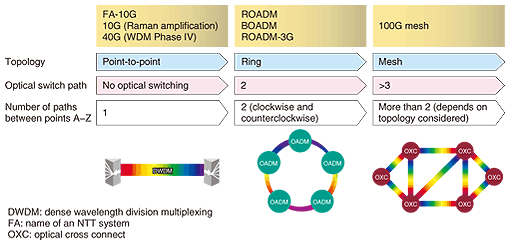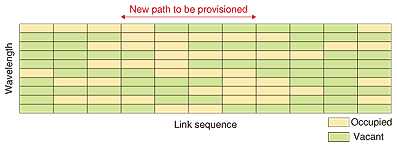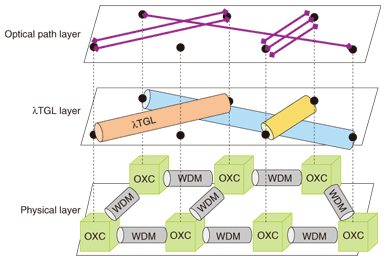 |
|||||||||||||||||
|
|
|||||||||||||||||
|
Feature Articles: Ultrahigh-speed Ultrahigh-capacity Optical Transport Network Vol. 9, No. 8, pp. 28–33, Aug. 2011. https://doi.org/10.53829/ntr201108fa4 Highly Efficient Photonic Networking TechnologyAbstractThis article introduces a networking management control technology that achieves highly efficient photonic networking by having λ paths (wavelength paths) and sub λ paths function cooperatively to increase the efficiency of user traffic accommodation.
1. IntroductionPhotonic transport networking in core networks conveys accumulated user traffic that is collected and distributed through access networks. The transport of traffic uses wavelength division multiplexing (WDM) transmission and optical path-switching. The requirements are shown in Fig. 1. In recent years, with the proliferation of broadband service through the penetration of fiber-to-the-home (FTTH) and expanding use of information and communications technology (ICT) in enterprise networks, increasingly higher-capacity path provisioning has been in demand for transport networking. In light of this, NTT Network Innovation Laboratories has been conducting research and development of 100-Gbit/s-class transmission technology and node technology [1]–[3]. Moreover, as the number of various high-capacity services increases such as datacenters and video delivery service, transport network flexibility will become important in addition to rapid path establishment. This is because long-term estimation of the traffic demand for these new services is difficult. Furthermore, considering severe price competition, further economization of transport networks is essential. On the other hand, to deal with the shrinking work force, from a network application perspective, operational cost reduction is also important. In regard to this, countermeasures such as utilizing remote control to decrease the number of service calls, automation, and simplified applications are necessary.
2. Network architectureTo deal with these requirements, the photonic network architecture is progressing along with optical transmission technology. 2.1 TransparencyIn the current optical transmission system, by using wavelength division multiplexing (WDM) technology, we have reached nearly 100 wavelengths per optical fiber. By using an optical fiber amplifier, we can amplify a large multiplexed optical signal of this type all at once. However, repeated optical amplification leads to the accumulation of noise. Moreover, optical fiber group velocity dispersion*1 and a nonlinear effect*2 occur owing to the physical characteristics of the optical fiber and they cause the optical signal waveform to distort during propagation. The distortion per wavelength becomes a serious problem as the transmission capacity becomes high. For this reason, before the distortion limit is exceeded, the optical signal must be converted into an electrical signal, the waveform reshaped, and electrical regeneration processing performed. Since this process must be performed for each wavelength, there are equipment cost, power consumption, space, and maintenance issues. In recent years, optical transmission technology has progressed and this type of discrete electrical regeneration processing is no longer used. The transmission distance and transmission capacity of optical transmission without electrical regeneration have increased rapidly, contributing significantly to the economization of transport networks. In other words, the reach of optical signals without electrical regeneration, i.e., the transparent domain of optical signals, has expanded rapidly. This is called the transparency of the photonic network.
2.2 Evolution of network topology (mesh networks)From the photonic networking topology viewpoint (Fig. 2), a high-capacity optical transmission system for long-distance spans, such as the Tokyo-Nagoya-Osaka link, is installed as a point-to-point system linking two points by using WDM technology. In this case, path changes require optical-to-electrical signal conversion electrical regeneration, as mentioned earlier, which involve incur cost and power issues. However, recent progress in optical transmission and switching technologies has enabled conversion-free optical path switching. In current metropolitan areas, optical switches have been put into practical use as reconfigurable optical add/drop multiplexers (ROADMs) that perform conversion-free optical path switching in ring networks. In ROADM ring networks, additional equipment and application costs can be reduced since operations such as path switching can now be accomplished from a remote location. We are currently further increasing the number of degrees of freedom for routing to produce multidegree ROADMs. In an ROADM ring network, there are only two choices for routing candidates, i.e., clockwise rotation or counterclockwise rotation, and these choices are referred to as degrees. For multidegree ROADMs, the maximum is three or more. This type of multidegree choice enables more degrees of freedom for optical routing without conversion or electrical processing. It allows us to configure an economical network. Furthermore, the network topology has evolved from a ring to a mesh.
2.3 Multilayer transportThe diversification in transport technologies has led to multiple alternatives for transmitting the same volume of traffic. For example, in the case of transmitting user traffic with a bandwidth of 10 Gbit/s, there are many technologically feasible ways to transmit a signal besides a direct 10G (G: Gigabit/s) optical wavelength (λ path), such as transmitting using a 10G electrical path and optical-channel data unit 2 (ODU2) as a sub λ path, using time division multiplexing (TDM) to multiplex 40G and 100G wavelength transmissions, or using pseudo-wire technology*3 based on multiprotocol label switching transport profile (MPLS-TP) packet processing. The electrical technology has higher functionality than optical technology, and packet multiplexing (Layer 2) has higher functionality than TDM (Layer 1). On the other hand, the electrical and packet processing have higher cost and power requirements, so their scalability to supporting future demands for high-capacity traffic will be an issue. For this reason, it is economical to use a lower layer for a given transmission function.
2.4 Routing complications and wavelength collisionMesh networks using multidegree ROADMs have more paths connecting a pair of points than ring networks, so path determination is more complex. Moreover, since no electrical processing is performed in the relay nodes along the path connecting the two points, the same wavelength must be used in the optical path between the starting and end nodes. For this reason, if we use randomly unoccupied wavelengths, some wavelengths cannot be assigned despite the existence of unoccupied wavelengths in each span. This is called wavelength collision and is shown in Fig. 3. Here, the span indicated in red is the new path to be established. If we look at each link span, it appears as if the unoccupied wavelengths indicated in green can all be guaranteed in the path. However, upon closer inspection, we see that it is impossible to guarantee the same desired wavelength for all the links in the path. For this reason, the wavelength exclusion process prevents path establishment despite the fact that there are available wavelengths. This reduces the overall utilization efficiency.
3. Network management control technology3.1 Multigranular accommodation design technologyTo resolve the abovementioned types of routing complications and wavelength collisions and ensure that economical transparent mesh networks are reliable, NTT Network Innovation Laboratories is investigating multigranularity accommodation design technology. For example, the basic function considering the hierarchy of the λ path and the electrical ODU path (sub λ path) is shown in Fig. 4. This function selects the path and wavelength for traffic having various bandwidths without squandering resources by considering wavelength collision and the advantages and disadvantages of each layer. The function displays the wavelength working conditions for each link. Furthermore, various constraints such as path arrangement, cable construction conditions, and actual network conditions are considered. In a transparent network, in addition to routing complications and wavelength collisions, the limit on the reachable distance for conversion-free optical transmission must be considered. Although the number of selectable routes is much higher in a transparent network, we must also determine whether optical transmission can be performed without conversion for each path. Moreover, even if we know the unused wavelengths for each optical fiber, we must comprehensively consider and judge the path, wavelength, and distance that the optical signal can be transmitted without conversion. To resolve these issues, we are investigating transparent network control technology that uses wavelength-grouped transmission-guaranteed link (λTGL) technology [4]. As shown in Fig. 5, the λTGL layer is defined for the estimated demand on the basis of a path designed in advance, considering the distance that the optical signal can be transmitted without conversion or wavelength collisions. The prepared λTGL establishes a virtual path whose path group capacity corresponds to the estimated demand. By specifying λTGL beforehand, we can reserve the required number of paths from the desired λTGL peers. Furthermore, since we can virtualize the supply of wavelength units, understanding what resources remain becomes simple. In this way, once we have established individual λ paths we do not need to consider the constraints on the transparent network characteristics, so we can expect a reduction in operating costs by simplifying the application and achieving economization through efficient usage of the transport equipment. Through initiatives of this type, the network resources can be optimized on the basis of the estimated demand and we can aim to economize the transport network. In the future, the appearance of various high-capacity services such as datacenters and image/video transfer services will lead to a higher proportion of high-volume traffic, for which fluctuation estimation is difficult. Therefore, transport networks will also need to have the flexibility to absorb fluctuations. To overcome these various issues and utilize to the maximum the merits of transparent network economization, we are further advancing multigranularity accommodation design technology and component technology investigations.
3.2 Transport network virtualizationIn future transport networks, we will have to cope with two traffic types: traffic with easy-to-estimate fluctuations and traffic with difficult-to-estimate fluctuations. If separate networks are configured for these requirements, then overall resources will be squandered. In order to provide economical transport services, we need a common transport foundation that can flexibly handle different types of demands. We are also investigating virtualization technology that provides transport services that satisfy different requirements and constraints on the same foundation as if the services were provided through separately configured dedicated networks. We expect that this type of transport network virtualization will be supported at the lowest level by a variety of virtualization technologies that are currently under investigation for cloud services. 4. Future expansionWith the aim of achieving further economization and application-cost reduction in photonic transport networks, we are advancing related standardization and collaborative research and development on higher-layer cooperation, flexible implementation to deal with demand fluctuations, and transport network virtualization. References
|
|||||||||||||||||

















